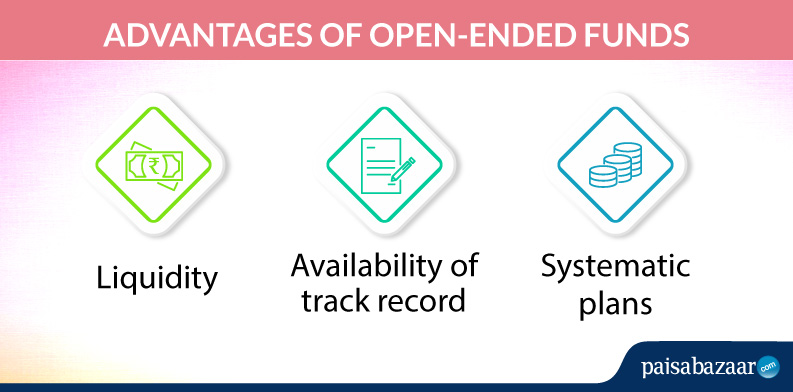Table of Contents :

Get Your Free Credit Report with Monthly Updates Check Now
An open ended fund is a fund which is officially launched after the NFO ends. It allows investors to enter and exit the fund anytime after they are launched. Whereas, a close-ended fund is a fund which does not allow entry and exit of investors after the NFO period, until maturity. Close-ended funds typically mature in 3-4 years from their launch date.
List of Top 10 Open Ended Equity Mutual Funds to Invest in 2020
| Fund Name | Expense Ratio (%) | 5-Year Return (%) | Net Assets (Cr) |
| SBI Small Cap Fund | 2.29 | 17.51 | 2,704 |
| Motilal Oswal NASDAQ 100 Exchange Traded Fund | 0.54 | 17.35 | 218 |
| Mirae Asset Emerging Bluechip Fund | 1.78 | 16.8 | 8,219 |
| Aditya Birla Sun Life Banking & Financial Services Fund | 2.41 | 15.11 | 1,806 |
| ICICI Prudential Banking and Financial Services Fund | 2.12 | 14.65 | 3,290 |
| Invesco India Financial Services Fund | 2.59 | 14.5 | 175 |
| Motilal Oswal Multicap 35 Fund | 1.75 | 14.09 | 13,235 |
| Aditya Birla Sun Life India GenNext Fund | 2.53 | 14.03 | 1,192 |
| Axis Focused 25 Fund | 2.02 | 13.71 | 8,384 |
| Canara Robeco Consumer Trends Fund | 2.68 | 13.52 | 354 |
Open Ended Funds v/s Close-Ended Funds
An open-ended fund allows investors to enter and exit the fund anytime after the NFO, whereas a close-ended fund restricts the entry and exit of investors to the NFO period. Moreover, unlike close-ended funds, open-ended funds do not have a limitation on the number of units they can issue. More units of an open-ended fund get created when an investor invests his/her money in the fund. Similarly, when an investor redeems his/her units of an open-ended fund, the mutual fund units are taken out of circulation.
While open-ended funds allow investors to make use of systematic plans – systematic investment plans (SIPs), systematic withdrawal plans (SWPs) and systematic transfer plans (STPs), close-ended funds do not support this facility.

A Good Credit Score shows that you manage Your Finances Well Check Score
Advantages of Open-Ended Funds

- Liquidity: Open-ended funds provide high liquidity as they allow investors to redeem the fund units at any time they want. The fund units are redeemed at the fund’s net asset value (NAV) of the day on which units are redeemed.
- Availability of track record: Unlike close-ended funds, the performance track record of an open-ended fund spanning across different market cycles is available. This allows investors to take a well-informed decision.
- Systematic plans: Open-ended funds allow investors to make use of systematic plans both for the investment and withdrawal purposes. An investor cannot make use of SIPs, SWPs and STPs with close-ended funds.
Disadvantages of Investing In Open-ended Funds
Open-ended funds feature a number of advantages, however, they do carry some risks with them too.
- Firstly, unlike close-ended funds, open-ended funds are vulnerable to large inflows and outflows. A sudden outflow can force a mutual fund manager to sell holdings at rock-bottom prices, causing a loss to all unit holders in the fund.
- Moreover, open-ended funds also carry a significant amount of market risk. The NAV of an open-ended fund fluctuates every day owing to stock market volatility. Thus, one must cautiously invest in open-ended funds.
- The liquidity offered by open-ended funds can also be a disadvantage. Since there is no lock-in in case of open-ended funds, investors may be tempted by greed to invest more money in bull markets and by may redeem units in volatile conditions owing to fear.
- Open-ended funds also have exit loads. These are charges levied upon you if you exit the fund within certain predefined time periods, typically up to 1 year. Thus, the ultimate earnings from an open-ended fund gets reduced if it attracts capital gains tax.
Who Should Invest in Open-ended Funds?
Open-ended funds are suitable for investors who wish to invest in a liquid investment instrument and are willing to undertake market risk and cash flow risk for high returns.
Tax Treatment of Open-ended Funds
The tax treatment of an open-ended fund will depend on whether it is an equity fund or a non-equity fund. You can read about taxation of equity mutual funds and non-equity mutual funds here.

Get Free Credit Report with Complete Analysis of Credit Score Check Now
FAQs on Open-Ended Fund
Ques. Is it possible to choose a periodic investment plan to invest in an open-ended mutual fund?
Ans. Yes. All open-ended funds allow investors to choose a periodic investment plan while investing. The option of SIP mode of investment allows the investor to invest small amounts at regular intervals.
Ques. Which is better: open-ended or closed-ended mutual funds?
Ans. Open-ended funds allow the investor to enter and exit the fund anytime unlike close-ended funds where the investment duration is fixed. Open-ended funds also facilitate transactions through SIPs and SWPs, which is not allowed in the case of close-ended funds.
Ques. How to redeem open-ended mutual funds?
Ans. Open-ended funds allow you to redeem your fund units at any time of your choice. The value of your funds units will be calculated as on the day of application for redemption. You can read the detailed process of how to redeem open ended mutual funds here.
